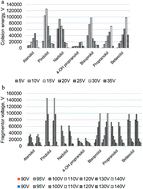A new analytical method for the determination of beta-blockers and one metabolite in the influents and effluents of three urban wastewater treatment plants
Abstract
Pharmaceuticals are emerging contaminants in waste waters from where they are discharged into surface water, so they may be harmful to aquatic organisms. Beta-blockers are consumed in high tonnage every year owing to the rise in cardiovascular disease of the population, and are incompletely metabolized. They are eliminated from the body as the parent drugs or as metabolites into wastewater. A sensitive method using off-line solid-phase extraction (SPE) and liquid chromatography coupled with mass spectrometry (LC-MS/MS) has been developed for the determination of 6 beta-blockers (bisoprolol, nadolol, betaxolol, atenolol, propranolol, pindolol) and one metabolite (4-hydroxy propranolol) in the influents and effluents of three urban waste water treatment plants (WWTPs). Extraction of the compounds was performed on Oasis C18 cartridges at pH 10 adjusted with ammonium hydroxide. As the LC mobile phase, formic acid 0.1% in water and methanol in gradient elution was used to separate the analytes in 13 minutes on a Luna C18 column kept at 45 °C. A linear response was obtained for all substances in the range of 1–100 ng mL−1 with determination coefficients >0.99. The parameters of the SPE procedure and of the LC-MS method were optimized to obtain the best results. The method was validated and beta-blocker recoveries after SPE in waste water were in the range of 71.2–103.3% with satisfactory intra-day and inter-day precision (RSD%) being located between 4.7 and 8.4%, and 8.1 and 14.4%, respectively. Optimization of LC-MS parameters generated low LOQ values between 0.34 and 7.37 ng mL−1. Atenolol was detected in all samples at higher average concentrations which ranged between 94.6 ng L−1 and 208.6 ng L−1 (effluent samples, influents). The other 3 beta-blockers: bisoprolol, betaxolol and propranolol were detected in influents in mean concentrations of 100.1 ng L−1, 44.9 ng L−1 and 26.8 ng L−1 and in effluents in mean concentrations of 51 ng L−1, 16.9 ng L−1 and 19.4 ng L−1. Propranolol was eliminated with the lowest average yields ranging from 25.19% to 31.78%, whereas atenolol, bisoprolol and betaxolol were eliminated from WWTPs with average yields ranging from 44.97 to 60.96%, 46.8 to 52.9% and 47.05 to 69.08%, respectively. Results obtained suggest that the adopted wastewater treatment processes are not efficient to remove these compounds and by penetrating into surface waters through evacuated effluents they can adversely affect aquatic organisms.



 Please wait while we load your content...
Please wait while we load your content...